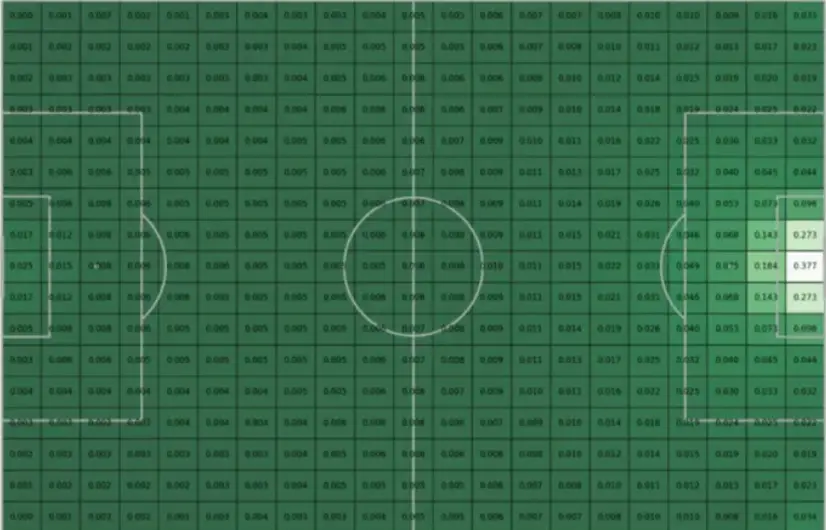Goal Multiplicator - A New Metric for Detecting the Quality and Importance of a Goal
Introduction
Do you really think that Maradona’s "goal of the century" against England in World Cup 1986 has the same “value” as Bellingham’s goal against Osasuna, 9th in La Liga, on 2023/2024 matchday?! For me, obviously NO… but for all international rankings, both are classified as “just” a goal, as “1” in scorers tables. My goal is to take a subjective description and reduce it to a number facilitating analysis, comparison, and, in general, the scouting process. This is the reason why I tried to develop a new metric called Goal Multiplicator (mG) to detect the importance, beauty, style, difficulty, and then, in general, the added value brought by a player when scoring a goal.
Idea
Goal Multiplicator (mG) can be defined as a new statistical metric able to detect the added value brought by the scorer when scoring a goal. The idea of a goal multiplicator entered my mind some months ago when I was analyzing a match. I came across a situation in which it was unfair to assign the same “value” (of 1) for 2 goals completely different in difficulty, importance, and beauty. From that moment I started thinking about a formula that would have allowed me to solve this problem. It was not easy at the beginning, then my degree in economics helped me. I decided to use a macroeconomic concept that, in my opinion, could have been readjusted and adapted in this field: the Keynesian Multiplicator. Keynesian Multiplicator is based on an economic policy formula. It allows us to measure the percentage growth in national income relative to the increase in one or more macroeconomic variables that compose aggregate demand. In simple words, it measures how much national income increases considering the rise of some macroeconomic variables. My idea was to use this concept and adapt it to football. In particular to scoring actions.
Why is it Useful?
In my opinion, a new metric allowing to obtain an objective value that measures the “quality” of a goal scored can be really meaningful for data analyst and, especially, for football clubs and federations to develop their scouting and decision-making process. Concretely, it can help clubs avoid making bad choices when buying new players, especially offensive players. For example, Real Madrid's purchase of Luka Jovic in summer 2020 for 63 million was one of the biggest mistakes by the most important club in football history. He played 51 matches in 3 years scoring just 3 goals in all competitions, and it was not a problem of injuries but of bad scouting that could probably have been avoided by Goal Multiplicator (mG). In this case, Real Madrid, using mG, would have been able to see that the added value brought by Jovic in his 40 goals with Eintracht Frankfurt was smaller than they thought. But let’s understand better what is concretely the multiplicator.
Variables
To create this new metric, I used both established variables and new variables. Established variables: - xG (Expected Goal) = it measures the quality of a chance created, before the shot); - xGOT (Expected Goal On Target) = it measures the probability of an on-target shot resulting in a goal); - xT (Expected Threat) = it measures the probability of scoring from a given rectangle that, together with the others, covers the entire playing field (see next image).

New variables: - Shot quality = the quality of the shot taken by the scorer, using xG and xGOT; - Goal importance = the importance of a goal scored, for ex., winning goal, draw goal, +2 goal, etc.); - Team ranking = the importance of the team against which the goal is scored, considering the category of the scorer’s team; - Time = the moment of the match in which the goal is scored divided by minutes; - Carry = the added value of the scorer’s carry with the ball before the shot, using xT. To understand better I bring you the example of Bellingham’s double against Barcelona in season’s 1st "Clásico" in October:

1st goal: mG = 2,2 -> see the goal video 2nd goal: mG = 1,2 -> see the goal video In this case, thanks to this metric, we can detect added value brought by Bellingham in his 2 goals against Barcelona. Instead of considering these just as 2 goals, or 2 “points” in the scorer's table, the new value will be 3,4 (= 2,2+1,2), so an added value of 1,4 for these 2 goals. As you can easily understand, through this new method we can change the concept of the scorers table, making it more meaningful for scouts, coaches, managers, and agents. Let’s see an example…
Sample Case
Scorers table of La Liga 2023/2024 first half of the season (after 21 matches): Scorers table: 1) Dovbyk 13 2) Bellingham 13 3) Morata 13 Scorers table (by mG): 1) Bellingham 18,9 2) Morata 18,6 3) Dovbyk 16,7 From this example, we can see the benefits of the Goal Multiplicator. The second table, indeed, assumes a different shape with respect to the classic one. By calculating goals with mG we can better understand the “quality” of goal scored because we are able to transform a complex action into a number, facilitating analysis and comparison. In this case, the quality of goals scored by Bellingham and Morata is clearly higher than Dovbyk’s one. Bellingham has an added value of 5,9 (= 18,9 - 13), Morata of 5,6 (= 18,6 - 13) and Dovbyk just 3,7 (= 16,7 – 13). From this, we can easily calculate the Added Value Ratio (AVratio): Bellingham = 0,45 (= 5,9/13); Morata = 0,43 (= 5,6/13); Dovbyk = 0,28 (= 3,7/13). AVratio is calculated by dividing the total added value by all goals scored. We obtain a really useful ratio that we use to understand the average added value brought by the player in his goal action. The higher is AVratio, the more the goal scored depends on the quality of the player. The normal scorers table shows us just how many goals have been scored by players, in this case, all three players scored 13 goals, but it doesn’t consider how these goals have been scored.
Conclusion
After having read these 5 pages I'm sure you understood why I decided to create this new metric and why I think it is so useful. Nowadays all football clubs, as all companies, are forced to be up to date so as not to lose positions towards other companies/clubs. In fact, it's no longer possible for football clubs to make decisions without using data, some more and some less but all companies have a data-driven decision-making process. The development of this new metric is in line with the current decision-making process, just because the main function of the Goal Multiplicator is to provide new data to facilitate and improve a football club’s scouting process. P.S.: If you want more information or if you want to suggest some adjustments don’t hesitate to contact me at niccolobecattini08@gmail.com



